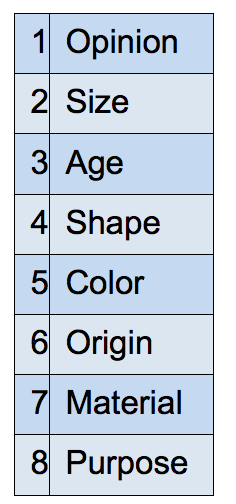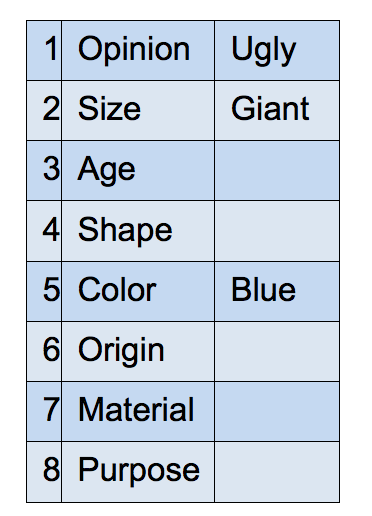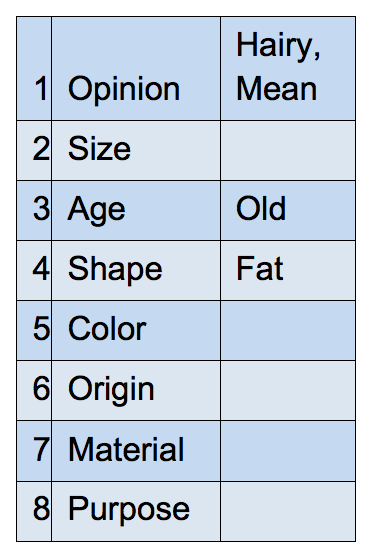Are you an English as a Second Language (ESL) writer guilty of making some of the more common ESL writing mistakes? Do you mix up your subjects and objects, write your adjectives all out of order, and confuse annoying English verbs that mean nearly the same thing?
Are you even aware that you are making these mistakes?
Kibin is here to help you improve your written English. We edit hundreds of ESL essays every month. By evaluating a selection of these essays, I’ve uncovered some of the more common ESL writing mistakes. These mistakes can make the difference between writing like a native English speaker and … well … not!
If you’re an ESL writer who wants to improve your English writing skills, then this post is for you. If you are a native English writer, then this post can serve as a good review for you too as, believe it or not, you also might be guilty of making some of these errors.
In this post, I’ll give you three common ESL writing mistakes that we’ve spotted in essays and some easy ways to learn to fix them.
Common ESL Writing Mistake #1: Improper Adjective Order
An adjective is a word that is used to describe a noun (like fat, green, or nice). And a noun, by definition, is a person, place, or thing (like cat, hot dog, Australia, or man).
If you are unfamiliar with English, then it may seem like the order of adjectives isn’t very important, so you might write something like this:
“The blue, giant, ugly sea monster swims in the ocean.”
In this sample sentence, the adjectives are: blue, giant, and ugly.
A native English speaker will (hopefully) write the sentence like this:
“The ugly, giant, blue sea monster swims in the ocean.”
The only difference between these two sentences is the order of the adjectives—the meaning is pretty much the same. However, having the wrong order of adjectives definitely makes your writing more confusing for the reader.
So, what is the proper order of adjectives? And how can you avoid making this mistake in your documents?
Here is a table that shows the eight different types of adjectives and the order they should be in, numbered from 1 to 8:
With this table as our guide, the order of adjectives in our sentence should go like this:
Once we put the adjectives in the table, we can see that the order of adjectives is ugly, giant, and blue. So again the proper sentence reads, “The ugly, giant, blue sea monster swims in the ocean.”
Let’s try this with another sentence.
Incorrect sentence: “The fat, hairy, old, mean man told us to stay off his lawn.”
The adjectives in this sentence are: fat, old, mean, and hairy.
Let’s put them in order:
Now we have arrived at “The hairy, mean, old, fat man told us to stay off his lawn.”
I know you were tempted to put hairy in the material box … I mean the guy is really hairy, right? But, in this case, hairy is an opinion. It’s a matter of perspective. After all, the man’s not really made out of hair, which is what it sounds like if you call him the “mean, old, fat, hairy man.”

(Image “Hairy Man from Munich” 16th Century.)
I hope this easy lesson helped teach you about the proper order of adjectives. If you need practice, check out this great series of exercises on adjective order offered by the University of Victoria English Language Center.
Common ESL Writing Mistake #2: Mistaking the Difference between Make and Do
“I have a lot of homework to make and, after, I will do a cake!”
Among the top most common ESL writing mistakes we see in the essays we edit is confusion between the verbs make and do.
Verbs are words that describe actions (to make, to do, to run, to sing…etc.).
In English, make and do are two different verbs, whereas in many other languages, like French and Spanish, one verb works for both (faire in French and hacer in Spanish). No wonder it can be so confusing for ESL writers!
Here is an easy way to remember the basic difference between make and do:
Write do when you are performing an action or a task, and, in the end, you won’t have anything new to show for it.
&
Write make when you are creating or building something. In the end, you’ll have created something new!
Here are some examples:
- You make dinner. In the end, you’ve created a yummy meal—or at least an edible meal.
- You do the laundry. In the end, you may have clean clothes, but you haven’t created anything new (nope, those are definitely the same clothes you wore last week).
- You make a speech. You’ve just created an experience (good or bad!) for all the people who listened to your talk.
- You do the dishes. Again, nothing new here, just the same old dishes, only cleaner.
- You make music. Amazing! You’ve just produced a sound where before there was silence.
- You do your homework. Are you starting to get the feeling that you use “to do” for a lot of boring, repetitive tasks and chores? Me too…
- You make peace. Congratulations, you’ve just created tranquility where before there was conflict!
Do can also be used when you’re not sure what you’re about to do—it’s a nonspecific verb that English speakers really like to throw around!
- The famous Nike shoe slogan says, “Just Do It.” You may ask, do what?
- Your mom may say, “Go do something if you’re bored!” Again, do what?
In both of these examples, the sky’s the limit. In this way, the verb to do is more versatile than its sister verb to make.
Nike probably can’t change their slogan to “Just Make It” because it would confuse their customers, who might ask, “make what exactly?” And then they might start picturing cooking an omelet or baking a cake. It’s confusing and incorrect to be nonspecific when using the verb to make.

To learn more about the differences between make and do check out these exercises offered by Woodward English.
Common ESL Writing Mistake #3: Confusing Me and I
Confusing I and me in a sentence is a mistake that both native English and ESL writers commonly make.
I know, you’re thinking a native writer probably wouldn’t write, “Me want to eat dinner.”
But a native writer might accidentally write, “Me and my boyfriend want to eat dinner,” which, when you break it down, is the exact same thing. Just take out the boyfriend (no, really! Take out “and my boyfriend” from the sentence) and suddenly you’re back at “me want to eat dinner … alone.”
Dinner alone? How sad!
Here’s the main difference between me and I.
I = the subject of the sentence. The subject is the thing, in this case the person, who is doing something, like eating dinner. “I want to eat dinner alone…”
Me = the object of the sentence. It is the thing that is having something done to it, like being left by your boyfriend. “…because my boyfriend left me.”
To recap:
- Incorrect: “Me want to eat dinner alone because my boyfriend left I.”
- Correct: “I want to eat dinner alone because my boyfriend left me.”
- Incorrect: “Me and my boyfriend want to eat dinner.”
- Correct: “My boyfriend and I want to eat dinner.”
When you confuse me and I in a sentence, you risk sounding a lot like what we imagine our cavemen ancestors might have sounded like!

(Image adapted from “Banksy’s Caveman.”)
- Incorrect: “Me want fries with that.”
- Correct: “I want fries with that.”
If you need more help learning the difference between me and I, check out this great learning exercise offered by ECEnglish.com.
Interview with an EFL Teacher
I had the opportunity to chat with EFL (English as a Foreign Language) teacher Megan Brockell. I asked her to give her best advice to students looking to improve their written English. Here’s what she had to say:
Me: Hi, Megan! Thanks for taking the time to chat with me today.
[sociallocker]Megan: No problem, thanks for having me.
Me: What’s your experience teaching ESL?
Megan: I’m a certified EFL teacher with a CELTA certificate from the University of Cambridge. I’ve spent two years teaching English to students in the towns of Quito and Manglaralto, Ecuador.
Me: Wow! That sounds amazing! So, what is one of the most common problems you find in your students’ ESL writing?
Megan: I often run into the problem of over-repetition of specific words or phrases. This can be a problem for native speakers, too, but at least they usually can think of another way to phrase things if pressed. But, an ESL student may not have enough of the language at their command to vary their sentence structures and word choices, which can be difficult.
Me: Yes, as an editor I agree that over-repetition can definitely ruin a good paper. So how do you suggest that ESL writers fix this problem?
Megan: Preferably, when they’re polishing up the paper, they should find some words or phrases that they can use to give the paper variety, though that brings me to another big mistake.
Me: Which is?
Megan: Misusing a thesaurus.
Me: Interesting! What exactly does that mean?
Megan: Honestly, the thesaurus by itself is very dangerous in the hands of an ESL student. The funniest words crop up in the middle of sentences that were obviously taken from a thesaurus. So yeah, language students need to check that the words they’re lifting from the thesaurus really match what they’re trying to say.
Me: And how can they do that?
Megan: The best way is for them to look for more information on the word or find it in sentences online.
Me: So basically, choose a word from the thesaurus and then Google it to see how it’s used in native English documents and blogs that you find online. Right?
Megan: Exactly! And also, don’t just choose a word because you think it sounds like something a fancy-talking English speaker would say.
Me: That’s funny, yes, don’t be like a fancy-talking English speaker! That’s a great tip.
Megan: Right! Keep it simple.
Me: Do you have any other good tips to share? Like, what’s the number-one best way for an ESL student to improve their English writing skills?
Megan: To all of you ESL students, it’s critical that you READ in English. A lot! Of course, you should make sure to pick material that isn’t way above or below your level, and you may want to stop and reflect on grammar, word order, and phrases that you’re not familiar or comfortable with as you read.
Me: Awesome, that’s a good tip for anyone looking to improve their writing skills. Read a lot. Well thanks again, Megan, for the great interview.
Megan: You’re welcome. I’d better get back to this book I’m reading … I’m trying to learn Italian![/sociallocker]
One Final Note
Don’t be afraid to be yourself in your writing. Writing in English is difficult to master, and your goal is progress, not perfection.
You’ll probably never write in perfect English—most native English speakers can’t even write in perfect English! Come to think of it, what is perfect English?
The point is, if you make little errors in your writing that give you away as being ESL, that’s okay!
There are a lot of successful ESL writers out there blogging and writing in less-than-perfect English (check out Happy Schools Blog for one great example). They’re successful because they’re trying and constantly improving, not because they’re perfect.
I hope you found this post to be helpful. We have more, great ESL writing tips where these came from coming up in the near future, so be sure to subscribe to our blog!


